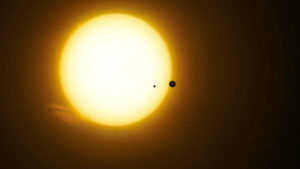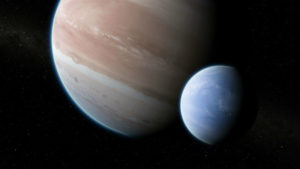Exoplanet Kepler-1625b might harbor a moon the size of Neptune—potentially the first confirmed exomoon—but researchers urge caution in interpreting the data.

Dan Durda
Last year, astronomers tentatively reported that they might have found the first known moon outside our solar system. Now, those same researchers think their claim just got a little stronger.
New observations from the Hubble Space Telescope lend credence to the idea that a moon roughly the size and mass of Neptune is orbiting about 3 million kilometers (about 2 million miles) from the Jupiter-size exoplanet Kepler-1625b, about 7,800 light-years from Earth.
For some perspective, according to René Heller (Max Planck Institute for Solar System Research, Germany), that one moon is about 10 times as massive as all the moons and rocky planets in our solar system combined.
But the discoverers themselves urge caution. “The first exomoon is obviously an extraordinary claim,” said Alex Teachey (Columbia University) at an October 1st press conference. “We’re not cracking open champagne bottles just yet.”
Teachey and colleague David Kipping (Columbia University) got their first hints of an exomoon after looking through data on 284 planetary systems from the Kepler space telescope. The telescope identifies exoplanets using the transit method, which relies on dips in starlight created by a planet passing in front of its sun. The team found one system that looked promising — a gas giant that transited about every 287 days, paired with the barest hint of a second, smaller transit from a potential moon — but they needed more data to be sure. So they turned to the Hubble Space Telescope, which spent 40 hours looking for confirmation on October 28th and 29th of 2017, when the planet was expected to transit again.
They weren’t disappointed. The hoped-for second transit came a few hours after the exoplanet's. What’s more, the planet started its transit about 78 minutes earlier than expected. While that could be evidence of other planets in the system tugging on this one, it could also be caused by a planet and moon orbiting each other.
“We’ve tried our best to rule out other possibilities such as spacecraft anomalies, other planets in the system, or stellar activity,” Kipping said. “But we’re unable to find any other single hypothesis which can explain all of the data we have.”
The research is published October 3rd in Science Advances.
Extraordinary claims require extraordinary evidence

Dan Durda
“I think we have to be very, very cautious,” says Stephen Kane (University of California, Riverside). “But it is very encouraging.” The Hubble data are critical, he says, because those observations were specifically targeted toward this system, as opposed to the Kepler observations, which cast a wide net to maximize the odds of finding planets.
“Alex and David did a marvelous job of examining the data from various perspectives and they are very transparent about the methods they used,” Heller says. “As to the confidence that I have in the actual existence of this exomoon, I remain skeptical.”
It’s not that exomoons are unlikely. And it’s not that the signal is too small to be reliable. Being a Neptune-size world, the moon blocks an amount of starlight that's actually on par with many planets already discovered, says Heller. The trouble is the noise in the data. Heller stresses that it is critical to understand all the potential sources of noise — the telescope, the instruments, and the star itself.
The authors do try and address these issues. One test was to look for the transit in multiple wavelengths. If the star were flickering, then red and blue starlight would dip by different amounts. But these transits look the same in all colors.
Data reliability aside, there is also the matter of the moon’s unusual size. While the ratio in masses between the moon and the planet is about the same as that of our Moon and Earth — about 1% — the entire system is roughly 1,000 times as massive as ours.
“The kind of system they found is so extraordinarily different from what we’re used to,” Kane says. “It raises a whole lot of questions about how did this come to be.”
There are three presumed ways to create a moon. It can form in the aftermath of something massive impacting a planet (such as Earth’s Moon). It can form in a disk of gas and dust encircling a planet (such as Jupiter’s Galilean satellites). Or it can be captured by wandering too close to a planet (such as Neptune’s largest moon, Triton).
All three methods are tough to reconcile with this situation. The moon’s orbit is stable, but how it got there is an open question. No one has really looked at how an impact on a gas giant planet could produce a moon, Kipping said. A disk around a Jupiter-mass world occasionally gives birth to such a moon, according to recent simulations. “It’s kind of the tip of the iceberg, but you do sometimes form moons that big,” said Kipping.
However, Heller argued in a paper earlier this year that the masses in the Kepler-1625b system are off the charts with regards to calculations of how things form in a circumplanetary disk. And capture, he finds, requires that the moon once had a mini-Neptune companion that got ejected in a close encounter with the planet — a plausible though unlikely scenario that posits two large worlds once gravitationally bound to one another.
“This moon, if confirmed, must have formed through a yet unknown astrophysical mechanism,” he says.
The next step is to get more data. To that end, Teachey and Kipping have applied for time on Hubble in May 2019, when the planet is expected to transit next. One more transit with the moon in the right position based on its predicted orbit could clinch the case. “If we see that,” Kipping said, “then I think we’re done.”
References:
A. Teachey and D. M. Kipping. “Evidence for a Large Exomoon Orbiting Kepler-1625b.” Science Advances. October 3, 2018.
R. Heller. "The Nature of the Giant Exomoon Candidate Kepler-1625 b-i." Astronomy & Astrophysics. February 26, 2018.
M. Cilibrasi et al. "Satellites Form Fast & Late: A Population Synthesis for the Galilean Moons." Monthly Notices of the Royal Astronomical Society. August 9, 2018.
 2
2









Comments
Robert-Casey
October 3, 2018 at 3:50 pm
They might be able to look for extra planets using radial-velocity. Then they could rule that out if they see only the known planet, or if any other planets have periods that won't create a false moon signature.
You must be logged in to post a comment.
fif52
October 25, 2018 at 6:29 pm
Quite possible Kepler-1625 has 5 moons of which Kepler-1625b is the 2nd and largest. And 2 are binary.
By their size and the Sun's mass of 1.1 a similarity can be ascertained, with the oversized planets maybe appearing larger for their size. .
You must be logged in to post a comment.
You must be logged in to post a comment.